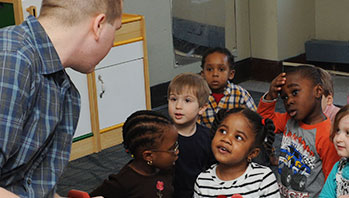- chart paper
- markers
- objects with a variety of surfaces, such as brick, wood, plastic, grass
- scrape
- sound
- surface
- tap
MA Standards:
Speaking and Listening: SL.PK.MA.1 Participate in collaborative conversations with diverse partners during daily routines and play.
English Language Arts/Language/L.PK.MA.1 Demonstrate use of oral language in informal everyday activities.
Language: L.PK.MA.6 Use words and phrases acquired through conversations, listening to books read aloud, activities, and play.
MA Draft STE Standards:
Physical Sciences/Matter and Its Interactions/Properties of Matter PS1.B Differentiate between the properties of an object and those of the material of which it is made in science explorations and activities such as art and music.
Physical Sciences/Energy and PS4.B Apply their understanding in their play of how to change volume and pitch of some sounds.
Head Start Outcomes:
Language Development/Receptive Language Attends to language during conversations, songs, stories, or other learning experiences.
Language Development/Expressive Language Uses language to express ideas and needs.
PreK Learning Guidelines:
English Language Arts/Language 2 Participate actively in discussions, listen to the ideas of others, and ask and answer relevant questions.
Talk Together: Exploring Surfaces and Sounds

© Commonwealth of Massachusetts, Department of Early Education and Care (Jennifer Waddell photographer). All rights reserved.
STEM Key Concepts: Sounds have a source; Different objects make different sounds
ELA Focus Skills: Active Listening, Listening and Speaking, Vocabulary
Display the materials and tell children you want them to use the materials to help them recall the tap and scrape observations they made on different surfaces during earlier explorations.
Review some of the surfaces and how they were the same or different. (hard, soft, bumpy, smooth) On chart paper make a list of the surfaces and textures that children mention. After you’ve discussed surfaces and textures, talk about the types of sounds produced when those surfaces are tapped and scraped, and guide children to compare. Allow them to demonstrate as they respond to questions. Ask,
- What did it sound like when you tapped and scraped the grass? How was it different from tapping the wood?
- Did one surface sound louder than another when you tapped it? Why do you think so?
Then tell children they are going to go outdoors to explore more surfaces and sounds.
